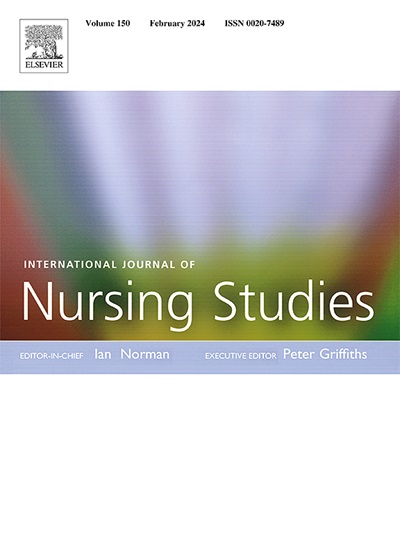非药物干预对危重患者预后的比较效果:系统回顾和网络荟萃分析
IF 7.1
1区 医学
Q1 NURSING
引用次数: 0
摘要
背景危重症患者的预后受到广泛关注。已经提出了多种非药物干预措施;然而,它们的相对有效性仍然不确定。目的评价和比较危重患者非药物干预对重症监护病房(ICU)获得性无力、肌力、日常活动、生活质量和身体机能的影响。方法综合检索PubMed、Embase、Cochrane图书馆、Web of Science、中国生物医学、中国国家知识基础设施和万方数据库,从成立至2025年8月,纳入在ICU住院超过48小时的成人随机对照试验。使用with Cochrane Risk of bias tool 2.0 (RoB2)评估偏倚风险。使用Stata version 16.0进行网络meta分析。利用累积排序曲线下曲面(SUCRA)对干预效果进行排序。研究方案已在PROSPERO注册(CRD42024499277)。结果共纳入45项研究,评估了9项非药物干预措施。体育锻炼结合电刺激、体育锻炼结合虚拟现实技术、体育锻炼结合营养补充、单独体育锻炼可显著降低icu获得性虚弱的发生率,优势比(OR)、95%可信间隔(CI)分别为0.14(0.09,0.24)、0.13(0.03,0.54)、0.46(0.22,0.94)和0.46(0.22,0.94)。对于肌肉力量,光疗表现出显著的改善,平均差异(MD)和95% CI为10.42(1.65,19.19)。体育锻炼联合电刺激和单独体育锻炼能有效改善日常生活活动,标准化平均差异(SMD)和95% CI分别为0.83(0.34,1.32)和0.51(0.09,0.93)。体育锻炼结合电刺激也改善了生活质量(SMD 0.50, 95% CI 0.07, 0.93)和身体表现(SMD 1.09, 95% CI 0.40, 1.77),而体育锻炼单独改善身体表现(SMD 0.61, 95% CI 0.14, 1.08)。敏感性分析表明,这些干预措施对生活质量和身体机能的影响是不稳定的。结论体育锻炼结合电刺激对减轻重症监护下获得性虚弱和增强日常生活能力最有效。光疗可显著改善肌肉力量。然而,这些干预措施对生活质量和身体表现的影响不太稳定。这些发现为危重患者的临床管理提供了有价值的见解。本文章由计算机程序翻译,如有差异,请以英文原文为准。
Comparative effectiveness of non-pharmacological interventions on the prognosis of critically ill patients: A systematic review and network meta-analysis
Background
The prognosis of critically ill patients has received extensive attention. Multiple non-pharmacological interventions have been proposed; however, their comparative effectiveness remains uncertain.
Objective
To evaluate and compare the effectiveness of non-pharmacological interventions for critically ill patients on the incidence of intensive care unit (ICU)-acquired weakness, muscle strength, daily activities, quality of life, and physical performance.
Methods
A comprehensive search was conducted in PubMed, Embase, the Cochrane Library, Web of Science, China Biology Medicine, Chinese National Knowledge Infrastructure, and Wanfang databases from inception to August 2025 for randomized controlled trials involving adults hospitalized in the ICU for more than 48 h. Risk of bias was assessed using the with Cochrane Risk of Bias tool version 2.0 (RoB2). Network meta-analysis was performed using Stata version 16.0. The surface under the cumulative ranking curve (SUCRA) was utilized to rank intervention effectiveness. The study protocol was registered in PROSPERO (CRD42024499277).
Results
A total of 45 studies evaluating nine non-pharmacological interventions were included. Physical exercise combined with electrical stimulation, physical exercise combined with virtual reality technology, physical exercise combined with nutritional supplementation, physical exercise alone significantly reduced the incidence of ICU-acquired weakness, with odds rations (OR) and 95 % confidence intervals (CI) of 0.14 (0.09, 0.24), 0.13 (0.03, 0.54), 0.46 (0.22, 0.94) and 0.46 (0.22, 0.94), respectively. For muscle strength, light therapy showed significant improvement, with mean differences (MD) and 95 % CI of 10.42 (1.65, 19.19). Physical exercise combined with electrical stimulation and physical exercise alone effectively improved activities of daily living, with standardized mean differences (SMD) and 95 % CI of 0.83 (0.34, 1.32) and 0.51 (0.09, 0.93). Physical exercise combined with electrical stimulation also improved quality of life (SMD 0.50, 95 % CI 0.07, 0.93), and physical performance (SMD 1.09, 95 % CI 0.40, 1.77), while physical exercise alone improved physical performance (SMD 0.61, 95 % CI 0.14, 1.08). Sensitivity analysis indicated that the effects of these interventions were unstable for quality of life and physical performance.
Conclusion
Physical exercise combined with electrical stimulation appears most effective in reducing ICU-acquired weakness and enhancing daily living activities. Light therapy significantly improved muscle strength. However, the effects of these interventions on quality of life and physical performance were less stable. These findings provide valuable insights for the clinical management of critically ill patients.
求助全文
通过发布文献求助,成功后即可免费获取论文全文。
去求助
来源期刊
CiteScore
15.00
自引率
2.50%
发文量
181
审稿时长
21 days
期刊介绍:
The International Journal of Nursing Studies (IJNS) is a highly respected journal that has been publishing original peer-reviewed articles since 1963. It provides a forum for original research and scholarship about health care delivery, organisation, management, workforce, policy, and research methods relevant to nursing, midwifery, and other health related professions. The journal aims to support evidence informed policy and practice by publishing research, systematic and other scholarly reviews, critical discussion, and commentary of the highest standard. The IJNS is indexed in major databases including PubMed, Medline, Thomson Reuters - Science Citation Index, Scopus, Thomson Reuters - Social Science Citation Index, CINAHL, and the BNI (British Nursing Index).

 求助内容:
求助内容: 应助结果提醒方式:
应助结果提醒方式:


